Flash’s two sons with Jenny-Bell:
Golden Gate Surprising Viggo at Morning Sky and
Golden Gate Surprising Kip at Morning Sky
Photo copyright C. Gardner
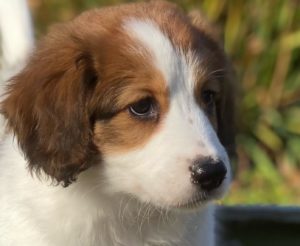
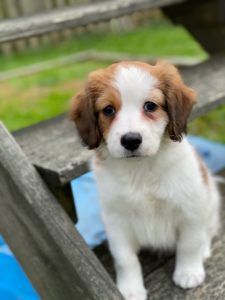
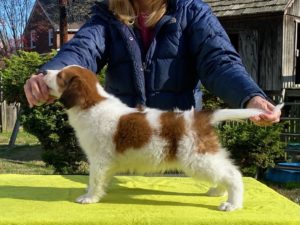
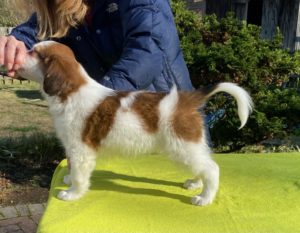
2 beautiful puppies are born 09/28/20 near Philadelphia, USA, at Morning Star Kennel

Nederlandse Kooikerhondjes in California
Flash’s two sons with Jenny-Bell:
Golden Gate Surprising Viggo at Morning Sky and
Golden Gate Surprising Kip at Morning Sky
Photo copyright C. Gardner




2 beautiful puppies are born 09/28/20 near Philadelphia, USA, at Morning Star Kennel

2 beautiful puppies are born 08/04/2020
Ati is co-owned with Susan van Dyke/Saliforth


As part of educating future and current Kooikerhondje owners, as well as breeders, I would like to share my observations of this aspect of the temperament of the breed.
This article is not science or evidence based and no genetic research on this topic exists in the breed. It comes from someone who has owned and has been around many Kooikerhondjes in different countries since 1998.
While all of us know how loving and loyal and simply beautiful this breed is, why do we recommend that they need homes with enough dog experience?
Most of us stumble upon the following description about the breed: “reserved”; “sensitive”; “can be reactive”;
Well, what does that mean? What should new owners prepare themselves for? Is there a typical age when that breed specific temperament becomes apparent? Yes. Let’s explore.
My observations have been that the breeds temperament and outgoingness has improved a lot since I first met them. The improvement is more apparent when it comes to the dog-human interaction than the dog on dog interaction. Meaning that in 1997, I did experience this breed as more cautious around strangers than what I notice these days. Well, is that a result of breeding, raising or pure luck? Many of you have met Kooikers and say “they are not as shy as I expected them to be”! Great! That is good feedback and a good development. However, they are usually no big fans of toddlers, rough and loud children or sudden unexpected movements in general. They are…sensitive.
I personally have not observed much change in terms of the adult/adolescent Kooikerhondje’s interaction around other dogs. Many need a bigger personal space than the average dog their size. They might not tolerate unusual behavior of other dogs and are quick to respond in showing their disapproval of behavior they feel is inappropriate although to the humans and other dogs, it is not! They are, on average, not big fans of strange dogs rushing into their faces. Again, exceptions exist but I am talking about the average Kooiker. Intact male Kooikerhondjes can be loud and snarly, intact females can be quiet and calm until they quickly snap without much warning. This certainly is a behavior or trait we NEED to educate any new owner about and prepare them so that they are successful with their new Kooikerhondje.
Does this run in certain lines? I am not so sure. Some lines seem to produce sharper offspring but I would say that even very sweet and mellow parents and siblings can have an offspring that turns out to be snarlier and more unpredictable than the others. This is tricky!
You might ask: “Can you observe this when they are puppies and are still at the breeder?” Honestly, I don’t think so. You can maybe see which puppy is the more confident and dominant one, but that is not what I am describing here as a typical Kooikerhondje trait.
When would this behavior show up? In my experience, it usually starts to show up when the dog enters adolescence. Some as early as 8 months, others in later adolescence around 18 months. It can improve with aging and stable positive experiences and consistent training.
Are there triggering experiences for a Kooikerhondje that can worsen this behavior? Yes, absolutely. Often times, a Kooikerhondje was overwhelmed in a situation which can be ever so slightly noticeable and not easy to pick up by the owner. It could be the big dog at the dog park that ran over in an attempt to play, it could be the neighbor kid racing by screaming, it could be a person walking up in the dark or with a funny hat when your Kooiker connects this experience in a wrong way and the next time, out of insecurity and for self protection, snarls and barks. Our initial response is most of the time to pull the dog back on the leash, to talk calmly “Oh no, Bobby, we don’t do that!” or to even get angry and yell – Those reactions will not help your Kooikerhondje overcome the situation and learn. Kooikerhondjes need to be read well by their owner and – BEFORE they react in an unwanted way, they need to be taken out of the situation AND the situation should be practiced (sometimes over and over again) in a safe and managed environment.
I’d like to make sure that this particular behavior I am describing is a reactiveness out of sensitivity to the environment. It needs to be clearly distinguished from aggression which is an unprovoked and completely unpredictable behavior to either human or dog with loss of control and sometimes includes breaking skin. That still happens in the breed. Certainly, bad experiences can trigger a dog with more reactivity at baseline to become truly aggressive. Aggression can also be caused by underlying medical issues including brain tumors, epilepsy, thyroid dysfunction etc. This needs to be assessed thoroughly by a veterinarian.
Another observation of mine is the fact that countries/cultures seem to have different thresholds of what is considered “normal” dog behavior/ interactions and what defines “reactivity”. In western Europe, most dogs are naturally kept intact. More places allow dogs off leash (not dog parks) and it is more common to bring dogs to restaurants and public places. It is considered normal that dogs interact while making noise and that can include a snarl, a bark or even a little scrabble. Moving to the United States has taught me that most dogs are neutered/spayed here at a young age, maintain a more playful attitude that way and interact in smaller spaces, like in dog parks. Growling or barking is quickly judged as bad and dogs are pulled apart before they can figure the situation out. The Kooikerhondjes potential to react might fit less into what the average dog owner is used to in the USA.
Again, the question becomes, is this genetic and part of the breed? I would say yes, it is to a certain degree typical and to be expected in the Kooikerhondje.
Ok, so after learning about that trait, many still pursue getting their first Kooikerhondje puppy. Besides education what to expect, what can one do to prevent this issue from becoming problematic? Most Kooikerhondje puppies are cute, outgoing, social and should not have any major problems. Pay attention once they have entered adolescence to small incidents, set them up for success, see the world in Kooikerhondje eyes, continue monitored socialization as MUCH as you possibly can (ideally with a trainer or a training group), work immediately on any snarl, reactiveness, possessiveness you observe, continue a routine and don’t let your guard down until your Kooiker is fully matured (this can sometimes take years…). Interaction on leash (as nose to nose contact with another dog) – if absolutely required – is better for short moments only (like a quick sniff) and do not allow tension to build up, rather move your Kooiker away.
If we truly love this breed, we also need to accept the temperament trait I have been writing about, embrace it, educate about it and help improve it with knowledgeable and careful breeding choices.
I am definitely hoping for more research in this area and am happy to spearhead any studies in the future!
Respectfully, Susanne Martin
Born 10/03/2019:
2 girls, 3 boys;
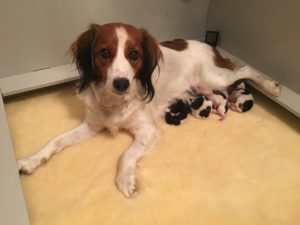
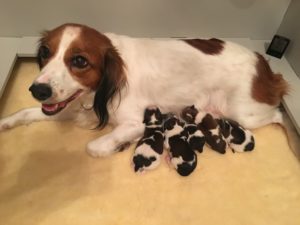
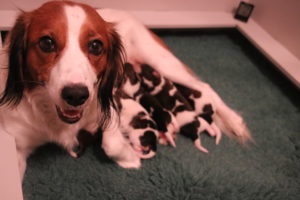
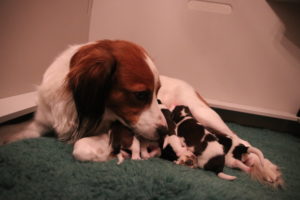
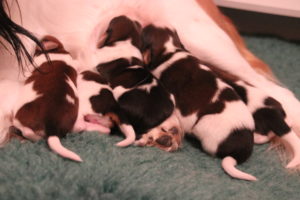
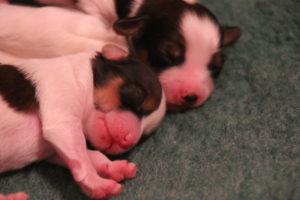
Polymyositis in the Nederlandse Kooikerhondje
By Yvet Opmeer, (DVM and PhD student), and Paul Mandigers
One of the many ongoing research projects in the neurology group focuses on the Kooikerhondje. The Nederlandse Kooikerhondje is traditionally a working dog for the duck hunt. When the endenkoois started to disappear at the beginning of the 20thcentury, the breed was endangered to go extinct. After the second world war, a lot was done to safe the breed. A small genetic foundation of 40 ancestors was formed. Since then, the population has grown a lot. In the meantime, more than 28.000 Kooikerhondjes were bred of whom currently about 7000 are alive.
Today, the Kooikerhondje is an internationally recognized breed with registrations in Europe, Japan and the United States of America. The Kooikerhondje has, like other breeds, many health issues. For two breed specific diseases, the responsible mutation was found (von Willebrand disease/vWD and the hereditary necrotizing myelopathy/ENM). We are currently working at full speed to research and better understand polymyositis since this illness is limiting the breed quite a bit.
The most distinguishing symptoms of this illness are movement and swallowing problems. Dogs with movement problems suffer from a muscle weakness and have a staggered gait. Kooikers with eating problems often drool and have issues swallowing. A combination of both presentations is possible. The diagnosis is made by a combination of symptoms, blood tests, electromyography (EMG) and a muscle biopsy. Usually, the CK (creatinine kinase level) is elevated.
A muscle biopsy is necessary for the diagnosis. Additional functional tests can help in finding the best options for management, prognosis and phenotyping. We find two forms of polymyositis in the Kooiker: a granulomatous myositis and a more lympho-histiocytic myositis.
The biggest focus of our research is, of course, the identification of the underlying genotype (the mutation). With help of a genome-wide association study (GWAS) and the complete genome sequencing (WGS), we have found a mutation. HOWEVER, not all homozygous (having two identical alleles of the particular gene) Kooiker get sick, and on the contrary, some heterozygous (having two different alleles of the particular gene) animals get sick as well. We hope that we can improve the phenotyping with a better pathological description and immunotyping in order to understand which Kooikers get sick and which don’t. The goal is, of course, to eliminate the disease in the population.
Our team consists of Dr. Peter Leegwater, Dr. Hille Fieten (genetics), Prof. Femke Broere (immunology), Prof. Kaspar Matiasek (neuro pathology), Dr. Paul Mandigers (neurology and project manager), Yvet Opmeer (DVM and PhD student) as well as breeder and breed clubs. As you can see, the research is in full speed. If you find in your practice a Kooikerhondje with these clinical symptoms or if you are treating a Kooikerhondje with the diagnosis of Myositis/Polymyositis, please do not hesitate and contact us:
Yvet Opmeer (y.opmeer@uu.nl) or Paul Mandigers (p.j.j.mandigers@uu.nl). With your help, we will be able to extend the research and hopefully, polymyositis will soon be a disease of the past.
Translation of the German translation (by Claudia Jurasek) by Susanne Martin, MD
Golden Gate Kooikers is located in the San Francisco Bay Area, California, USA.
Our goals are to educate about the breed and to produce healthy, sound Kooikerhondjes that can be successful in various areas of performance. Our focus is training them in search and rescue (SAR) disciplines.
